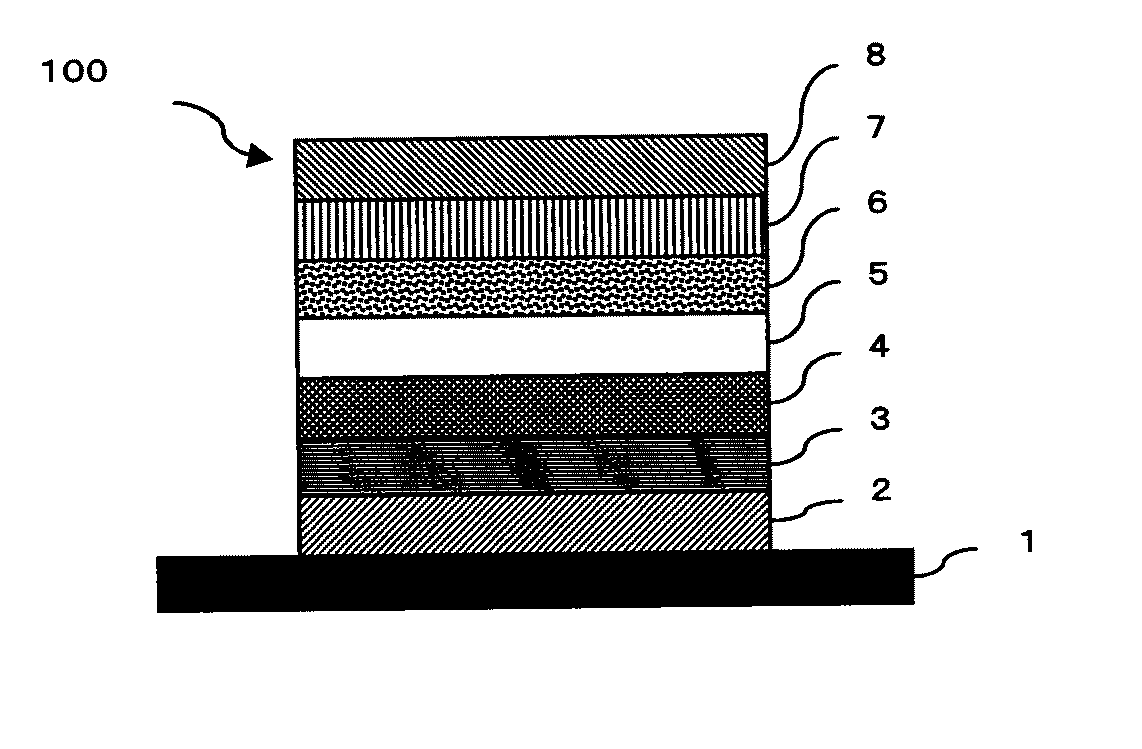Organic electroluminescence device and method of producing organic device
a technology of electroluminescence device and organic material, which is applied in the direction of discharge tube luminescnet screen, discharge tube/lamp details, coating, etc., can solve the problem of shortening the driving lifetime of the device, achieve the effect of reducing the driving voltage, excelling in the driving lifetime, and improving the chemical stability
- Summary
- Abstract
- Description
- Claims
- Application Information
AI Technical Summary
Benefits of technology
Problems solved by technology
Method used
Image
Examples
example 1
[0400]A glass substrate measuring 17.5 mm×35 mm (and 0.7 mm in thickness) was washed, successively, with a surfactant solution using ultrasonic, with extra-pure water, with extrapure water using ultrasonic and again with extrapure water, followed by drying with nitrogen blow and, finally, ultraviolet ray-ozone cleaning was conducted.
[0401]On this glass substrate, a layer containing a polymerization initiator was formed by wet coating method according to the following procedure.
[0402]Namely, spin coating was carried out under the conditions described below using a coating liquid (composition) that contains a polymer compound (weight-average molecular weight: 29400, number-average molecular weight: 12600, this will be hereinafter referred to as the “compound (P-1)”) having an aromatic amino group with a structure represented by the following formula P-1, as hole-transport agent, and a compound with a structure represented by the following formula A-1 (hereinafter referred to as the “c...
example 2
[0419]A homogeneous, laminated thin film (a thin film in which two layers containing a polymerization initiator and a polymerizable compound respectively are laminated) of which total thickness was 60 nm was obtained under the same condition as used for Example 1, except that the spin-coated film was heated in the air at 180° C. for 1 hour when forming the layer containing a polymerization initiator after irradiated with UV light using a high-pressure mercury lamp in an accumulated light amount of 5 J / cm2 (energy value of 365-nm light).
[0420]The substrate, on which the laminated thin film was formed, was set at a spin coater and 0.2 mL of xylene was dropped thereon in the form of a film, followed by allowing it to stand in the air at 23° C. for 10 seconds. Subsequently, the solvent was dried by conducting spin coating at 1500 rpm for 30 seconds. Then, the film thickness was measured, resulting in the value of 60 nm. In this way, insolubility of the produced film in xylene was verifi...
example 3
[0421]A homogeneous, laminated thin film (a thin film in which two layers containing a polymerization initiator and a polymerizable compound respectively are laminated) of which total thickness was 60 nm was obtained under the same condition as used for Example 1, except that the spin-coated film was heated in the air at 150° C. for 1 hour when forming the layer containing a polymerization initiator after irradiated with UV light using a high-pressure mercury lamp in an accumulated light amount of 5 J / cm2 (energy value of 365-nm light).
[0422]The substrate, on which the laminated thin film was formed, was set at a spin coater and 0.2 mL of xylene was dropped thereon in the form of a film, followed by allowing it to stand in the air at 23° C. for 10 seconds. Subsequently, the solvent was dried by conducting spin coating at 1500 rpm for 30 seconds. Then, the film thickness was measured, resulting in the value of 60 nm. In this way, insolubility of the produced film in xylene was verifi...
PUM
| Property | Measurement | Unit |
|---|---|---|
| carbon number | aaaaa | aaaaa |
| carbon number | aaaaa | aaaaa |
| carbon number | aaaaa | aaaaa |
Abstract
Description
Claims
Application Information
 Login to View More
Login to View More - R&D
- Intellectual Property
- Life Sciences
- Materials
- Tech Scout
- Unparalleled Data Quality
- Higher Quality Content
- 60% Fewer Hallucinations
Browse by: Latest US Patents, China's latest patents, Technical Efficacy Thesaurus, Application Domain, Technology Topic, Popular Technical Reports.
© 2025 PatSnap. All rights reserved.Legal|Privacy policy|Modern Slavery Act Transparency Statement|Sitemap|About US| Contact US: help@patsnap.com



